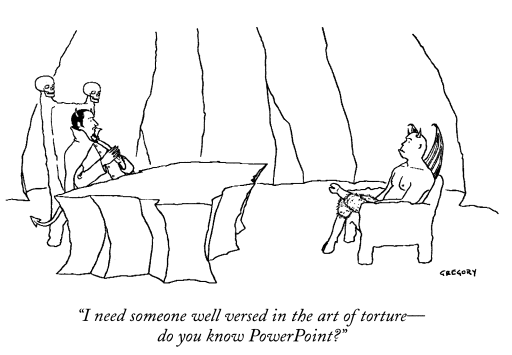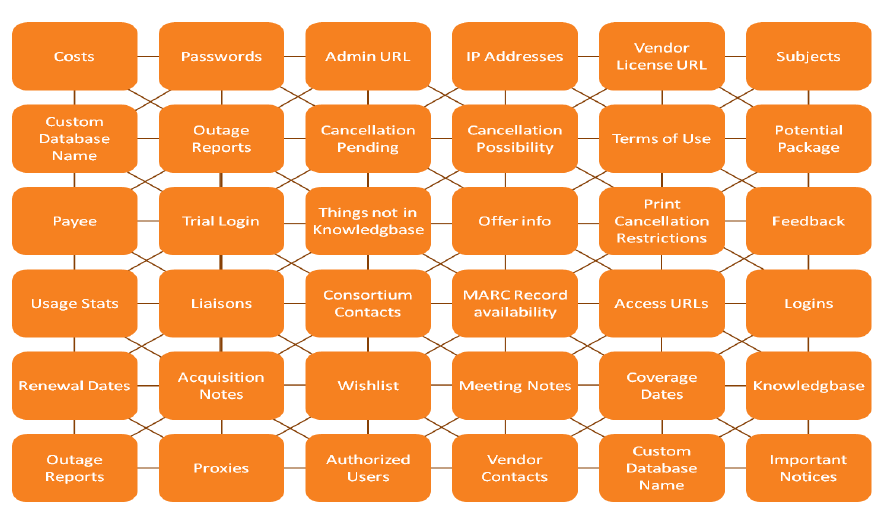Managing
the Electronic
Resources Life-cycle:
Creating a comprehensive
checklist
using Techniques for
Electronic
Resource Management (TERMS)
Nathan Hosburgh, Montana State University ╬ NASIG 2013
WHY?
Create a reference point
Organize workflow & create efficiencies
Foster effective communication w/n & across teams
Exercise responsible stewardship of resources
Document iterative processes that can be improved
What does "the checklist' look like?
Simple word doc or PDF
Spreadsheet
Database
Flowchart
Management System
Whatever works for you!
Disclaimer:
I suck at ppt and I do not want to torture you.

The e-resource life-cycle

Graphic from TERMS Wiki http://library.hud.ac.uk/wikiterms/Main_Page with slight modification
investigating new content
What is the goal?
Specify evaluation criteria
Consult with your team
Desktop review & trial
Communicate with vendors
Make a decision
know what you want to achieve
Identify & gauge demand
Purpose (teaching, research, other)
Response to course, research agenda, PDA
Electronic replacement for print
History of ILL requests
Integration with preferred platform
Budgetary concerns
Evaluation criteria
Audience appropriate?
Intuitive interface?
Compare platforms
Authentication/IP/proxy access?
COUNTER usage stats?
Integration into unified search tool?
MARC Record availability/quality/cost?
Administrative control?
(more) evaluation criteria
Preliminary license review
Unlimited simultaneous use
Remote/walk-in/alumni access
"Site" definition
ILL/course packs/e-reserves/LMS
Perpetual access & where?
Ebook format: PDF, epub, DRM?
get the right team
Single journals/small purchases - no team
Consider project template for large projects
Team Composition:
- E-resource Manager
- Collection Development Librarian
- Budget holder
- Subject Liaison Librarians
- Faculty outside library

review & trial
Satisfy demand with existing resource(s)?
Overlap analysis: coverage & duplication
Product reviews/comparison studies
Timing is important for trial
Publicize on blog, wiki, web, email
Usage stats for trial
Trial feedback
Longer trial is better - at least one month
talk to providers
Consortia arrangements?
Individual deals may be more flexible/advantageous
Better pricing for multi-year deal?
Inform vendor when looking at similar products
Understand fees and contract
Refer back to specification doc (criteria)
make a decision
Score resource against criteria
Criteria may be weighted based on priorities
Review can take a few hours or months
Document relevant points in ERM/spreadsheet
User feedback can be added to documentation

acquisition of new content
Compare specs between library & vendor
Negotiate contract terms & pricing
Review the license
Record administrative metadata

compare specifications
Library & Vendor agreement (selection criteria grid)
Purchase order?
DDA details & configuration
Specific contract for purchasing terms?
Annual renewal process?
Multi-year discounts?
contract negotiation & pricing
SERU Guidelines may be used in lieu of license
Create list of 'deal breakers' & 'must haves'
Model license option
Base price on FTE that will use resource
Adjust price for product crossover
Everything is negotiable!
final license steps
Comprehensive license review
Forward to signing authority
Don't rush; protect yourself
Store countersigned e-copy
Record administrative data in ERMS:
- Payment terms
- Service terms
- License terms
- Renewal details

implementation
Test
Market
Train & Document
Launch & Feedback

testing the product
URL
Proxy/IP access
MARC Records
OpenURL
Admin interface
Usage stats
Access points
marketing the resource
Marketing plan?
Consider needs, wants, interests of users
Target specific user groups
Identify objectives of service/product
Develop marketing matrix
- Actions
- Responsibilities
- Timing
training & documentation
Update guides if replacing resource
May create library documentation
Check vendor documentation
Vendors provide free:
- Webinars
- Podcasts
- Conference Calls
- On-site visit
launch & feedback
Major changes may require 'soft launch'
Gather feedback via survey, focus groups, stats
Compare multiple access points for product
Timing of launch important

ongoing evaluation & access
Types of evaluation
Check the implementation
Ask your users
Track changes & issues
Communicate with the vendor

evaluation methods
Set consistent data points to measure
COUNTER-based stats
ISI Impact Factor
Eigenfactor
Journal Usage Factor project
Aggregated stats:
- Web page
- Discovery tool
- OpenURL
- ILS
check the implementation
Set up review schedule
After purchase: monthly, quarterly, annually
Check links & remote authentication
Check full-text access
General usability issues
ERMS reminder configuration
ask your users
Are e-resource needs being met?
Structured: LibQual+, survey
Unstructured: web comments, resource issues
Record comments in CRM or spreadsheet
Develop consistent approach; coherent reporting

monitor platform changes
Journal title transfers b/n platforms & publishers
'Transfer Code of Practice'
Team effort for quality control
Typical checks at renewal period
ERMS & subscription service aid verification
vendor communication
Keep records on each provider
- Correspondence
- Scheduled maintenance
- Specific problems
Information factors into renewal
Feedback may improve product
Join pertinent user groups for engagement
annual review process
Cancellation schedule
Consider new costs & terms
Examine usage stats
Communicate with stakeholders
Retain/renegotiate/cancel

schedule
Check required notice period on subscription
Examine price increase from last year
Renewals may occur throughout year
May be efficient to review resources in batch
Review new & established resources
Planning meetings for subject teams
review costs, terms, conditions
Contact vendor in advance of renewal
Analyze price increases against agreement
Consider other pricing options if available:
- Simultaneous users vs. site license
- Subscription vs. one-time purchase
- Annual vs. multi-year
usage statistics
Check if vendor is COUNTER-compliant
Compare hits/searches/downloads
Nuanced data in COUNTER (JR1 & JR1a)
Some stats are better than none at all!
Based on usage stats:
- Resource flagged for cancellation
- Evidence training/outreach needed
- Increase/decrease simultaneous users
importance of ERMS

communicate to stakeholders
Represent data clearly in reports
Overlap analysis via ERMS, Jisc ADAT, CUFTS
Longitudinal data across years is best
Challenge with streaming video & atypical resources
Resource errors & usability issues reported
making a choice
Retain, renegotiate, or cancel
Re-assess market for substitutions
Review new license for game changers
Cancellation talk may open negotiation
Expect flexibility from vendors
Explore availability of funds across campus

sources
CUFTS Open Source Serials Management: http://researcher.sfu.ca/cufts
Emery, J. & Stone, G. (2013). Library Technology Reports, 49(2).
Jacoby, B., York College of Pennsylvania [shared acquisitions checklist via ERIL-L 2012]
Jisc Academic Database Assessment Tool: http: //www.jisc-adat.com
Jisc Project Management Guidelines: http://tinyurl.com/jw4nz3t
Project COUNTER: http://www.projectcounter.org/
SERU Guidelines: http://www.niso.org/workrooms/seru
Stone, G., Anderson, R., & Feinstein, J. (2010) E-Resources Management Handbook.
Terms Wiki: http://library.hud.ac.uk/wikiterms/Main_Page
TERMS Wiki
Original Creators
Jill Emery & Graham Stone
Section Editors
TERMS 1: Investigating New Content - Ann Kucera (Baker College, Michigan)
TERMS 2: Acquiring New Content - Nathan Hosburgh (Montana State University)
TERMS 3: Implementation - Stephen Buck (Dublin City University, Ireland)
TERMS 4: Ongoing Evaluation and Access - Anita Wilcox (University College Cork, Ireland)
TERMS 5: Annual Review - Anna Franca (King's College, London, UK)
TERMS 6: Cancellation and Replacement - Eugenia Beh (Texas A&M University, Texas)